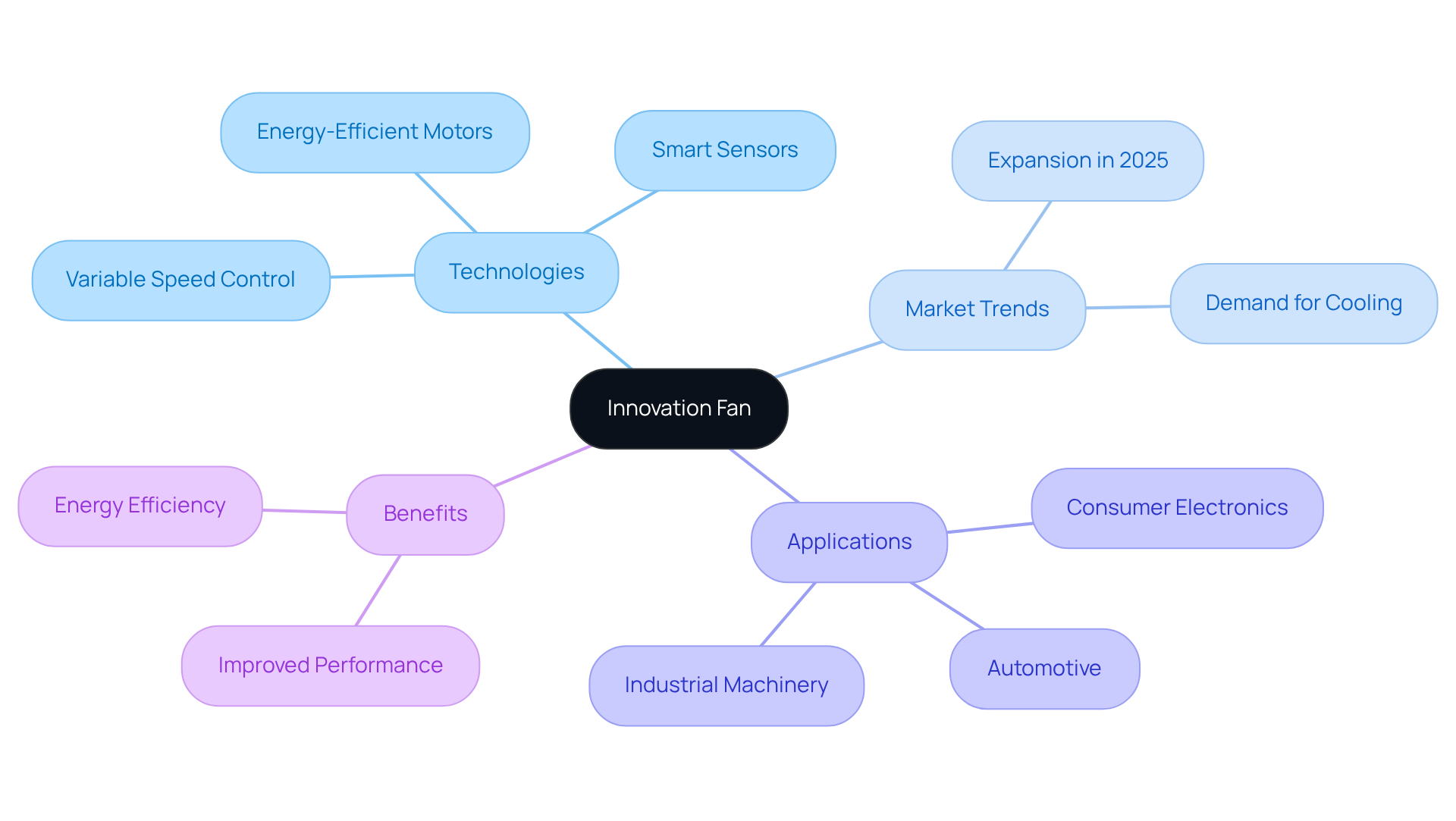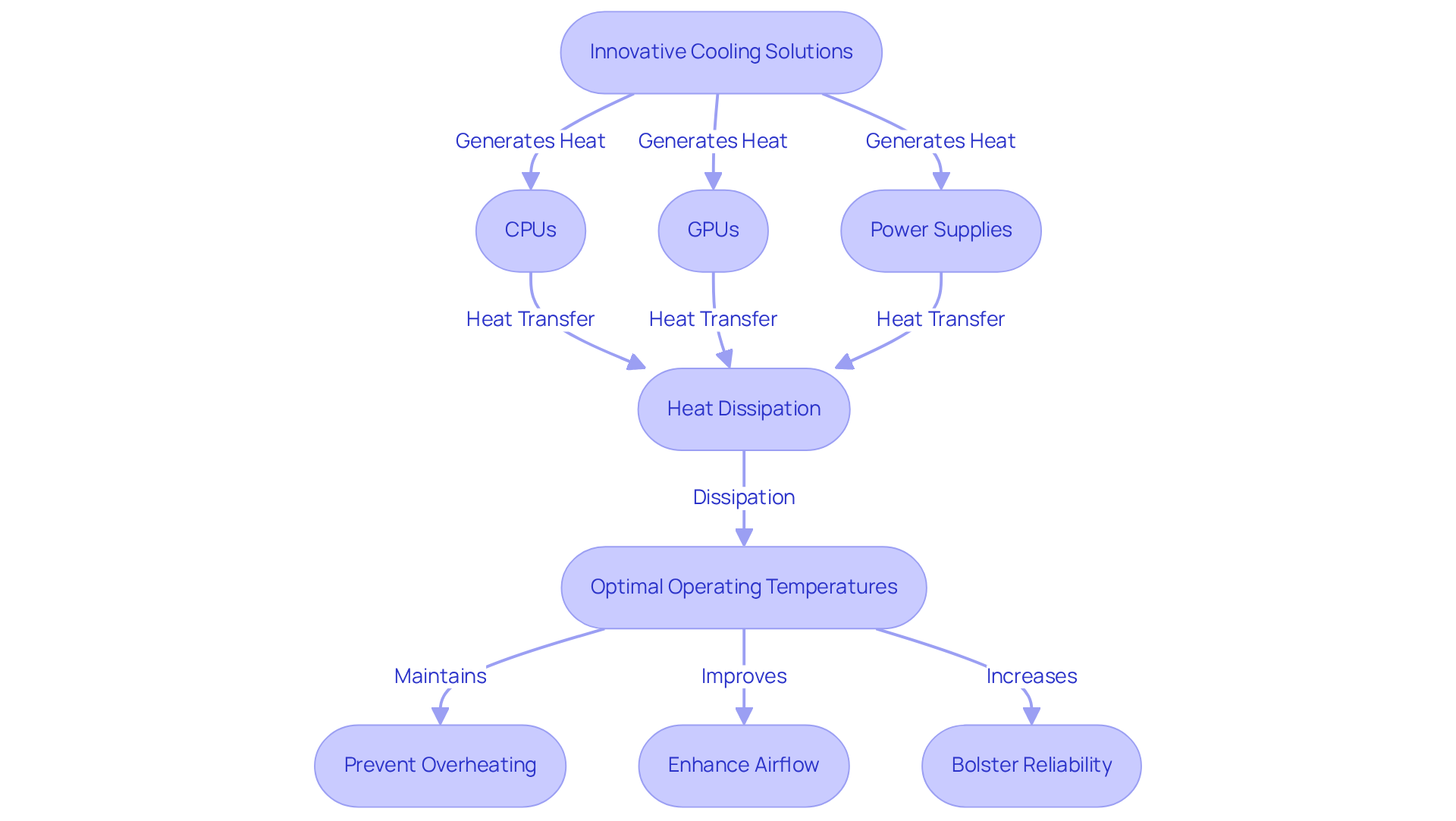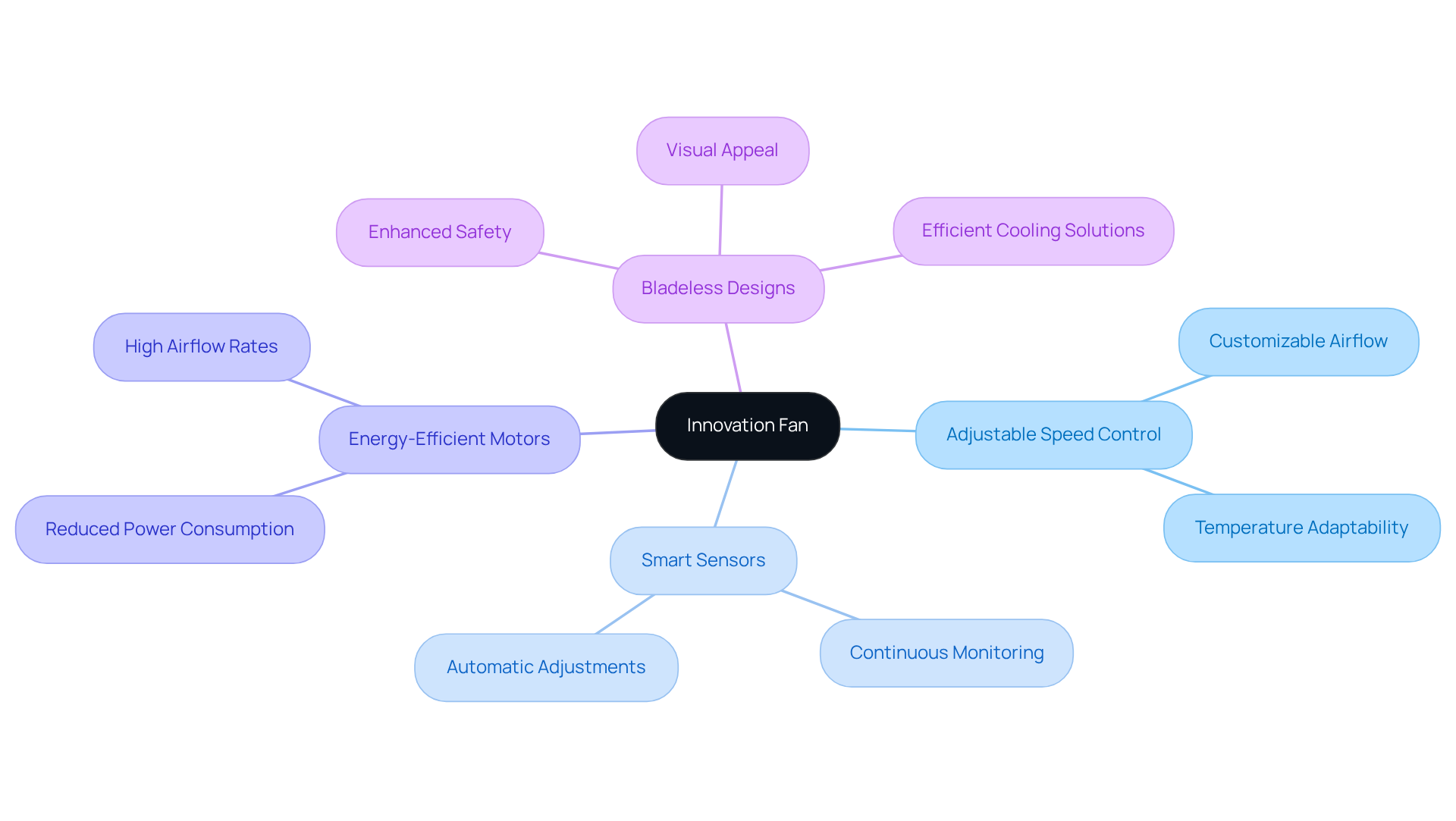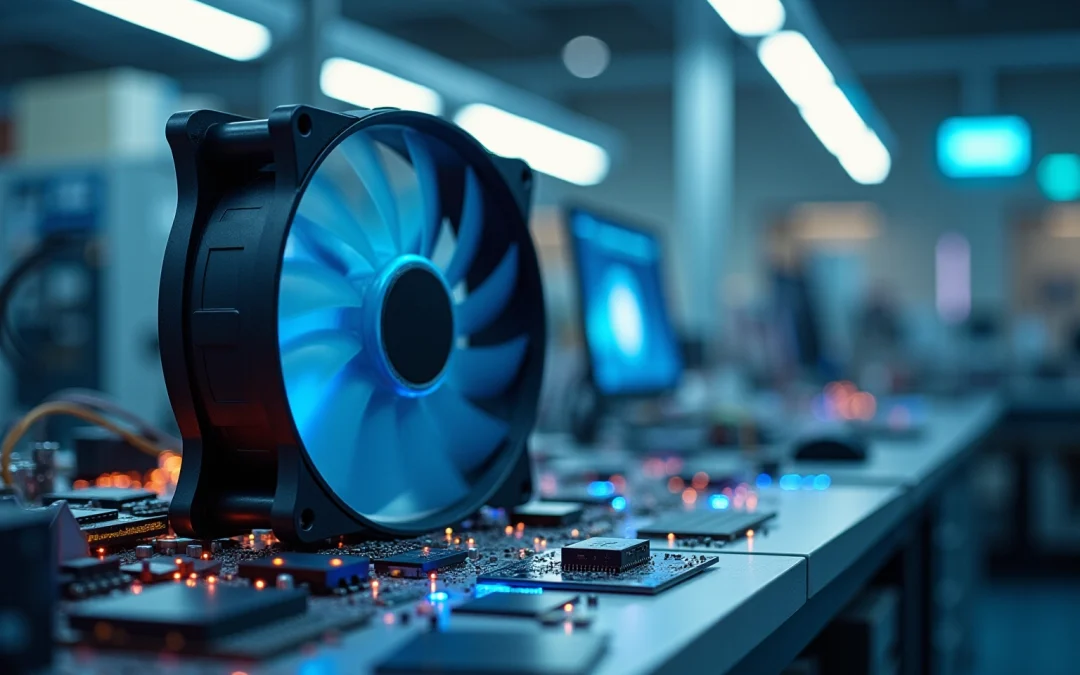Overview
The innovation fan represents a cutting-edge cooling solution designed to significantly enhance airflow and thermal management in electronic systems.
Featuring variable speed control and smart sensors, these devices are engineered to improve energy efficiency and performance.
By adapting to varying thermal loads, they play a crucial role in ensuring the reliability and longevity of sensitive electronic components across diverse applications.
This adaptability not only addresses the challenges posed by thermal fluctuations but also underscores the importance of integrating advanced cooling technologies in modern electronic design.
Introduction
Innovation fans are revolutionizing the landscape of electronic cooling solutions. They offer advanced airflow management that significantly enhances performance and energy efficiency. By integrating cutting-edge technologies such as variable speed control and smart sensors, these devices address the critical thermal management needs of modern electronics while playing a crucial role in prolonging the lifespan of sensitive components.
As the demand for more efficient cooling systems grows, it raises an important question: how do innovation fans adapt to the ever-evolving challenges of thermal regulation in diverse applications?
Define the Innovation Fan: Concept and Functionality
Innovation fans represent a cutting-edge solution designed to significantly enhance airflow and cooling efficiency within electronic systems. Unlike traditional units, these advanced devices employ technologies such as variable speed control, smart sensors, and energy-efficient motors. This integration allows for dynamic adaptation to varying thermal loads, thereby improving performance while reducing energy consumption. Their role is crucial in maintaining the thermal stability of electronic components, which is vital for ensuring longevity and reliability.
In 2025, the market share for temperature control technologies is anticipated to expand, driven by the increasing demand for effective refrigeration options in high-performance electronics. These devices not only enhance thermal efficiency but also contribute to the overall energy efficiency of electronic systems, addressing the growing concerns regarding energy usage in data centers and other applications.
The real-world applications of these innovative technologies are evident across various sectors, including consumer electronics, automotive, and industrial machinery. For instance, advanced cooling systems are employed in data centers to efficiently regulate heat dissipation, where cooling can account for up to 40% of total energy consumption. Engineers have noted that the functionality of these devices is paramount; they facilitate precise temperature control, essential for the optimal operation of sensitive electronic components.
As one engineer remarked, the versatility of new technologies across diverse thermal conditions enables remarkable efficiency improvements, rendering them indispensable in contemporary electronic design. Overall, the advancement of innovation fan technology is critical in enhancing the performance and sustainability of electronic devices.

Explore the Role of the Innovation Fan in Electronics Engineering
In the realm of electronics engineering, innovative cooling solutions play a pivotal role, primarily addressing the critical need for effective thermal management. These solutions are integral to thermal control frameworks, facilitating the dissipation of heat generated by essential electronic components such as CPUs, GPUs, and power supplies. By ensuring optimal operating temperatures, cooling devices are instrumental in preventing overheating, a condition that can lead to catastrophic failures or reduced performance.
Furthermore, these devices enhance airflow within enclosures, guaranteeing that all components receive adequate temperature regulation. This, in turn, bolsters the overall reliability and efficiency of electronic systems, underscoring the necessity of advanced cooling technologies in modern engineering.

Trace the Evolution of the Innovation Fan: Historical Context
The development of the inventive device can be traced back to the early days of electrical engineering, when basic mechanical systems were employed for cooling purposes. The introduction of electric motors in the late 19th century marked a significant turning point, enabling more efficient and controllable airflow. Over the decades, advancements in materials science and motor technology have culminated in the creation of high-performance devices that are quieter, more energy-efficient, and capable of functioning under varying conditions. Furthermore, the emergence of smart technology in the 21st century has transformed the landscape, appealing to the innovation fan with capabilities such as:
- Remote control
- Automated speed adjustments
- Seamless integration with building management systems

Analyze Key Features and Components of the Innovation Fan
The essential characteristics of modern air circulators include:
- Adjustable speed control, which empowers users to modify airflow based on specific temperature requirements.
- Many models feature smart sensors that continuously monitor temperature and humidity levels, automatically adjusting fan speed to ensure optimal performance.
- Energy-efficient motors represent another hallmark of these devices, significantly reducing power consumption while maintaining high airflow rates.
- Furthermore, some innovators in the field incorporate bladeless designs that enhance safety and visual appeal, all while delivering efficient cooling solutions.
Collectively, these features contribute to the versatility and efficiency of innovation fans across various applications, ranging from consumer electronics to industrial systems.

Conclusion
Innovation fans signify a transformative leap in thermal management technology, crucial for optimizing both the performance and longevity of electronic systems. By leveraging cutting-edge features such as variable speed control and smart sensors, these devices not only enhance airflow but also play a vital role in energy efficiency, effectively addressing the pressing demands of modern electronics.
The article delves into key insights regarding the functionality and applications of innovation fans. Their essential role in preventing the overheating of sensitive components is underscored, alongside their historical evolution from basic mechanical systems to sophisticated smart devices. The significance of these fans within electronics engineering is unequivocal. Their capacity to adapt to varying thermal loads while upholding energy efficiency positions them as indispensable tools across various sectors, including consumer electronics and industrial machinery.
As the demand for effective thermal management solutions escalates, embracing innovation fan technology becomes imperative for engineers and designers alike. The continual evolution of these devices not only mirrors advancements in materials and motor technologies but also emphasizes the importance of sustainability in electronic design. Investing in such innovative cooling solutions will undoubtedly enhance performance and reliability, paving the way for future advancements in the realm of electronics engineering.
Frequently Asked Questions
What are innovation fans?
Innovation fans are advanced devices designed to enhance airflow and cooling efficiency within electronic systems by using technologies such as variable speed control, smart sensors, and energy-efficient motors.
How do innovation fans improve performance?
They dynamically adapt to varying thermal loads, which improves performance while reducing energy consumption, thereby maintaining thermal stability of electronic components.
What is the expected market trend for temperature control technologies by 2025?
The market share for temperature control technologies is anticipated to expand due to the increasing demand for effective refrigeration options in high-performance electronics.
What sectors benefit from innovation fan technology?
Innovation fan technology is used across various sectors, including consumer electronics, automotive, and industrial machinery.
How do innovation fans contribute to energy efficiency?
They enhance thermal efficiency and contribute to the overall energy efficiency of electronic systems, addressing concerns regarding energy usage, especially in data centers where cooling can account for up to 40% of total energy consumption.
Why is precise temperature control important in electronic systems?
Precise temperature control is essential for the optimal operation of sensitive electronic components, ensuring their longevity and reliability.
What are some real-world applications of innovation fans?
Real-world applications include advanced cooling systems in data centers, which efficiently regulate heat dissipation, and various uses in consumer electronics and industrial machinery.
What is the significance of the versatility of innovation fan technologies?
Their versatility across diverse thermal conditions enables remarkable efficiency improvements, making them indispensable in contemporary electronic design.

